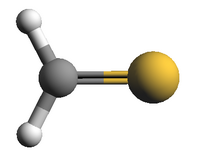Thioformaldehyde, doubly deuterated isotopolog
 | |
|---|---|
| Species tag | 048507 |
| Version | 3* |
| Date of Entry | Dec. 2023 |
| Contributor | H. S. P. Müller |
|
The present entry considers a large set of millimeter and
submillimeter data, such that it differs considerably from
the previous ones from Jan. 2019 and Feb. 2006,
in particular at higher frequencies or quantum numbers.
The (sub-) millimeter data were reported by | |
| Lines Listed | 2127 |
| Frequency / GHz | < 1500 |
| Max. J | 55 |
| log STR0 | -9.5 |
| log STR1 | -7.0 |
| Isotope Corr. | |
| Egy / cm–1 | 0.0 |
| µa / D | 1.6588 |
| µb / D | |
| µc / D | |
| A / MHz | 146399.5 |
| B / MHz | 14904.252 |
| C / MHz | 13495.833 |
| Q(300.0) | 7681.9201 |
| Q(225.0) | 4987.6118 |
| Q(150.0) | 2714.5057 |
| Q(75.00) | 960.5017 |
| Q(37.50) | 340.4640 |
| Q(18.75) | 121.1646 |
| Q(9.375) | 44.3733 |
| Q(5.000) | 19.2340 |
| Q(2.725) | 9.3545 |
| detected in ISM/CSM | yes |